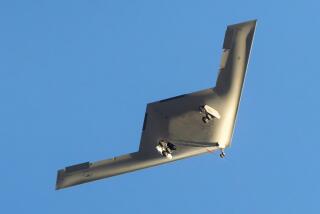Douglas Rolls Out Its First MD-11 in Style
- Share via
Six pairs of Finnish folk dancers escorted a hulking five-story-tall jetliner down the flight ramp at the McDonnell Douglas plant in Long Beach Thursday, part of a carefully crafted rollout ceremony to mark the delivery of the first MD-11.
The keys to the aircraft were turned over to Finnair Capt. Karlo Jaskari, who then became victim to a longstanding Douglas Aircraft tradition when his necktie was cut off for later enshrinement in a display case.
The ceremony, which took a month of planning by a committee of 25 Douglas employees, was a bright relief from the many financial difficulties facing Douglas on both military and civilian programs. It allowed company officials to highlight their success in moving the MD-11 program through a rigorous 10-month flight test program--an effort that culminated in government certification of the craft earlier this month.
Finnair Chairman Antti Potila called the new jetliner an “outstanding achievement” and said it would be placed in passenger service before Christmas. The airline--a Douglas customer since 1941, when it took delivery of its first DC-2--has orders and options for five more MD-11s.
About 1,000 Douglas employees, suppliers and news media representatives attended the delivery, which was notable for its dramatic presentation of the jumbo jet.
As a Finnish waltz played, the aircraft emerged into view from around a large hangar, made a sweeping turn and stopped with its nose towering over a podium. Dancers from the Katirilli Finnish Folk Dancers group performed.
After investing $700 million in development and $2.8 billion in manufacturing inventories for the MD-11, Douglas has been eagerly awaiting the day it could begin receiving cash payments for deliveries.
Douglas President Robert Hood predicted the company would recoup its investment within three years and start posting considerable profits on the program by 1992. With firm orders for 174 aircraft and total commitments for 375 aircraft, the MD-11 represents a third of McDonnell’s overall backlog.
But the firm, which has 10,000 employees assigned to the MD-11 program, still has a way to go before realizing profits. The average employee has only four years of experience, and so far the company is not satisfied with the number of labor hours it takes to produce an MD-11, said Lou Harrington, Douglas vice president and general manager for the MD-11.
“Right now, our costs are not at the level we would like them,” he acknowledged. But a cost reduction plan will reduce that level, Harrington added.
“This is not pie in the sky,” he said.
The other blemish on the MD-11 is its failure to meet guarantees for fuel economy. During flight testing, Douglas and its customers learned that the aircraft burns about 5% more fuel than expected, which would reduce its range or payload.
Harrington said the company has developed a plan to reduce MD-11 drag by 0.7% and improve the fuel burn of its General Electric engines by 0.9%, thus making up 1.6% of the excess fuel consumption.
In addition, the results of flight testing have enabled Douglas to increase the gross takeoff weight of the aircraft from 615,000 pounds to 618,000, which would allow the plane to meet all of its range and payload guarantees, Harrington said.
Even so, the aircraft would still burn more fuel, costing users more to operate it. Douglas will compensate customers for those costs, Harrington said. Since the problem originates with the jet engines, GE and Pratt & Whitney have made a commitment to “support” Douglas in that compensation, Harrington said.
In any event, he said, the cost is “not a significant number.”
More to Read
Inside the business of entertainment
The Wide Shot brings you news, analysis and insights on everything from streaming wars to production — and what it all means for the future.
You may occasionally receive promotional content from the Los Angeles Times.









